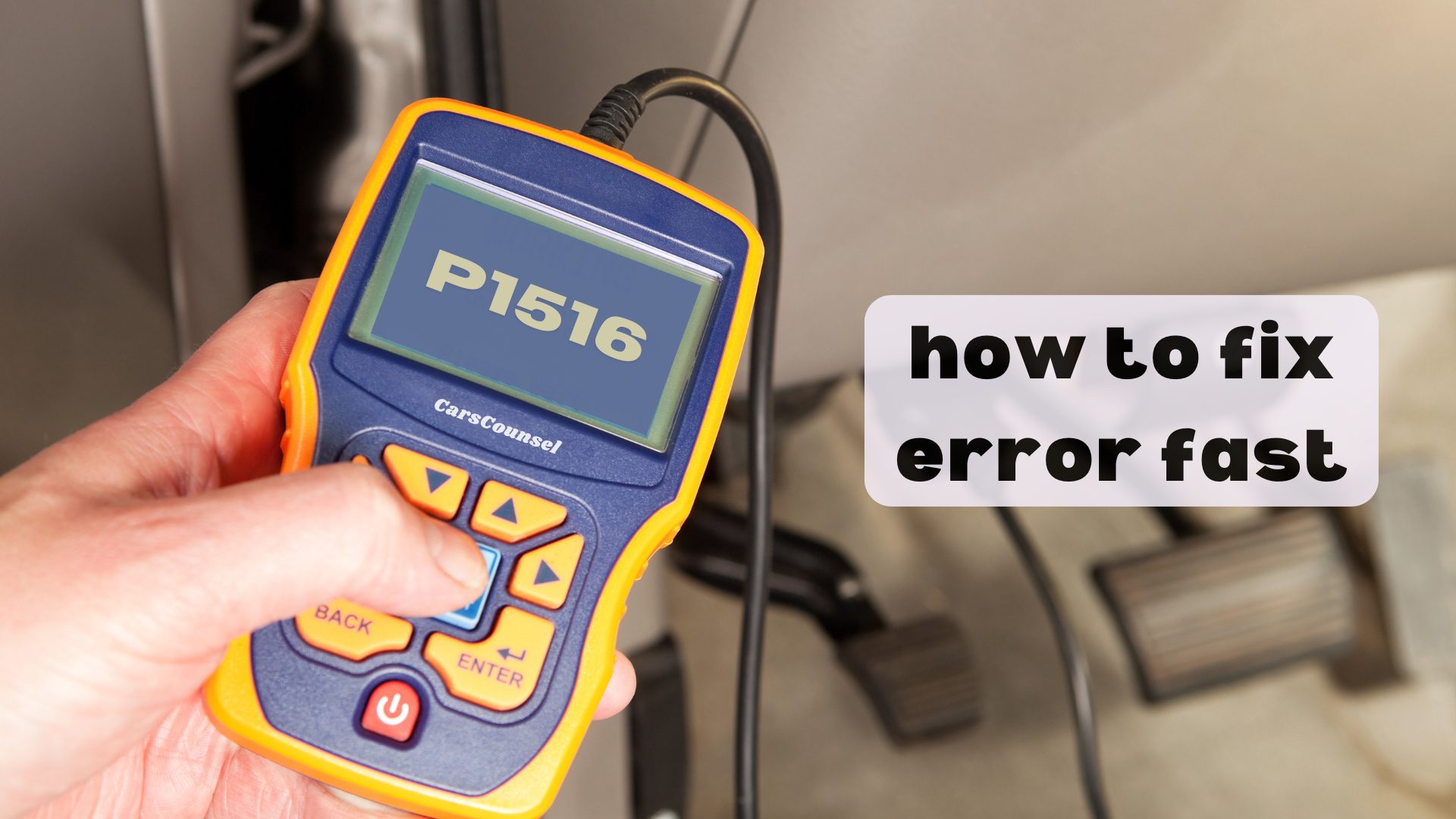Fixing the P1516 code can feel like navigating through thick fog—you need the right tools and steps to clear it up.
Start by using an OBD2 scanner to confirm the problem OBD2 Codes.
Then, visually inspect the throttle actuator control system. Did you know that cleaning the throttle body can really help?
Before jumping to conclusions, follow these key steps to tackle the error efficiently, making sure you don’t overlook any details that could save you time and effort.

Quick Navigation
Key Takeaways
- Use an OBD2 scanner to read and understand the P1516 error code.
- Look at the Throttle Actuator Control (TAC) system for any damaged or corroded wires and connectors.
- Clean the throttle body with a suitable cleaner to get rid of any dirt or buildup.
- Check and, if needed, replace the throttle actuator control module to make sure it works right.
Understanding the P1516 Code
Understanding the P1516 code is important because it deals with the electronic throttle control system (ETCS) and points to possible problems with the throttle actuator control module (TACM).
This code means that your car’s electronic systems, which control how the throttle responds, are having issues. The ETCS changes the throttle opening based on the accelerator pedal position sensor (APPS), allowing for precise control of engine power. Modern cars use these electronic systems instead of older mechanical linkages.
When the P1516 code appears, it can lead to unpredictable throttle response, slower acceleration, and warning lights on the dashboard.
Knowing what this code means and how to diagnose it is key to keeping your car running smoothly and efficiently.
Common Causes of P1516
Figuring out the common causes of the P1516 code can help you fix problems with your vehicle’s electronic throttle control system.
One major issue could be the Throttle Actuator Control (TAC) system, often due to a faulty TAC motor or damaged circuits.
Problems with the wiring, like corroded or damaged wires, can mess up the throttle response.
A bad Engine Control Module (ECM) might send wrong signals to the TAC system, which can affect how the engine runs.
A dirty or clogged throttle body can also cause issues.
Environmental factors like moisture or dirt can wear down TAC parts.
Knowing these common causes is key to keeping your throttle response and engine performance in good shape.
Diagnosing the P1516 Code
Diagnosing the P1516 code involves a step-by-step method to find problems in the electronic throttle control system (ETCS). First, check how the throttle responds and look at the electronic control parts. Use an OBD2 scanner to get diagnostic trouble codes (DTCs) and real-time data. Pay special attention to the throttle position sensor (TPS) readings; any differences can show issues. Check the wiring and connectors in the throttle actuator control (TAC) system to make sure they are in good shape. Here’s a table to help guide you through the diagnostic process:
| Step | Action | Tools Needed |
|---|---|---|
| Get Trouble Codes | Scan for codes | OBD2 Scanner |
| Check Wiring | Look for damage | Multimeter, Visual |
| Inspect Throttle Body | Clean or replace it | Throttle Cleaner |
| Test TAC Module | Check its operation | Diagnostic Software |
Follow these steps to accurately diagnose and fix P1516 issues.
Visual Inspection Steps
Start by carefully checking the TAC system’s wiring and connectors for any damage, rust, or loose connections. Look at the wires and connectors that connect the throttle actuator control module (TACM) to the electronic systems.
Any bad connections can mess up the throttle response and cause the P1516 code. Pay special attention to the harness and connectors, making sure they’re tight and clean.
Check for any worn-out or exposed wires that could cause short circuits. Also, look at the connectors for any moisture or dirt that could mess with the electronic signals.
A thorough visual inspection can often find issues quickly, saving time and avoiding more problems.
Throttle Body Cleaning
To clean the throttle body, first disconnect the battery to stay safe and avoid electrical problems.
Then, take off the air intake hose so you can reach the throttle body.
Use a throttle body cleaner and a soft brush to scrub away carbon buildup and dirt. Make sure you clean both sides of the throttle plate.
Don’t spray the cleaner directly on any electrical parts.
Once you’re done, put everything back together and reconnect the battery.
This helps keep your car running well and can stop the P1516 error code from showing up.
Regular cleaning keeps the electronic throttle control system working smoothly, cuts down the chance of issues, and boosts your car’s performance.
Replacing the TAC Module
To replace the TAC module, start by disconnecting the battery to avoid any electrical hazards and stay safe.
Then, find the TAC module, which is usually located near the throttle body. Unplug the connectors and carefully remove the bolts holding it in place.
Put in the new TAC module, making sure all the connectors are securely attached and the bolts are tightened properly.
To check if the new TAC module is working, reconnect the battery and start the vehicle. Look for any warning lights and test how the throttle responds.
If there are still issues, you might need to do more troubleshooting, such as checking for other related codes or inspecting the throttle body again.
If installed correctly, this should fix the P1516 code and restore proper throttle control.
Wiring and Connector Repairs
After replacing the TAC module, it’s important to check and fix any damaged wiring or connectors to ensure smooth communication in the throttle system.
Start by looking at the wiring harnesses for any signs of wear, corrosion, or breaks. Use methods like soldering and heat-shrinking to properly fix any damaged wires.
For the connectors, make sure they’re clean and securely attached; use contact cleaner to get rid of any debris or corrosion from the terminals. Also, check that the pins are properly engaged to avoid connection issues.
Replacing any damaged connectors can help prevent future problems. These steps ensure the throttle actuator control system works reliably, reducing the chance of recurring P1516 code errors.
Using Diagnostic Tools
Using diagnostic tools is crucial for figuring out why you’re seeing the P1516 code in your vehicle’s throttle control system. Here’s how you can go about it:
Connect an OBD2 Scanner: Plug an OBD2 scanner into your car’s diagnostic port to pull up any error codes, including P1516.
Check Real-Time Data: Use the scanner to look at live data, which helps you see how the throttle position sensor and throttle actuator control module (TACM) are performing.
Test Components: Use tools like multimeters to check the wiring and sensors to make sure everything is working properly.
These steps will help you quickly find and fix the issue causing the P1516 code.
Affected Car Models
Many cars with electronic throttle systems, especially the Chevrolet Silverado (2003-2007), Cadillac CTS (2004-2007), GMC Sierra (2003-2007), and Hummer H2 (2003-2007), often have problems with their throttle actuator control (TAC) modules.
This issue can trigger the P1516 code. The Chevrolet Silverado and GMC Sierra have similar designs, so they both face these TAC module problems.
Cadillac CTS models from 2004 to 2007 also deal with this, causing reduced throttle response and warning lights.
Knowing about these specific models helps you quickly identify the problem and fix the TAC system issues, getting your car back to normal.
Safety and Preventive Measures
Regularly taking care of and checking the Throttle Actuator Control (TAC) system is crucial for stopping the P1516 code and keeping your vehicle safe. Doing this ahead of time can help avoid poor throttle response and ensure your car runs smoothly. Follow your car’s maintenance schedule to spot problems early.
Important steps include:
- Regular Checks: Frequently look over the TAC system for any signs of wear or damage.
- Throttle Body Cleaning: Make sure the throttle body is clean to avoid dirt buildup.
More OBD-II Codes
Frequently Asked Questions
What Tools Are Needed to Replace the Throttle Actuator Control Module?
To replace the throttle actuator, you’ll need a socket set, some screwdrivers, an OBD2 scanner, and maybe a torque wrench. Make sure you disconnect the battery before you start for safety.
How Long Does It Take to Fix the P1516 Code?
Fixing the P1516 code usually takes about 1-2 hours. This depends on the diagnostic steps needed. Given common issues like reduced throttle response, it’s important to carefully inspect, clean, or replace parts as needed for a proper and efficient fix.
Can P1516 Affect Fuel Economy?
Yes, P1516 can affect fuel economy. When your throttle response is not working right, it messes up the air-fuel mixture, leading to poor combustion. This means you’ll get worse gas mileage and might have performance problems. Fixing the issue quickly is a good idea.
Is It Safe to Drive With a P1516 Code?
Imagine your car hesitating in traffic. It’s not safe to drive with a P1516 code. It affects your driving safety and engine performance, leading to reduced throttle control and possible dangers. Get it fixed right away to avoid expensive repairs.
What Are the Costs Associated With Fixing the P1516 Code?
Fixing the P1516 code can cost different amounts. A new TAC module (Throttle Actuator Control) usually costs between $150 and $300. On top of that, you might pay an extra $100 to $200 for labor, depending on your vehicle and local rates.
Conclusion
You can do this! Fixing the P1516 code might seem tough, but with an OBD2 scanner and some effort, you can handle it quickly.
Start by checking the throttle actuator control system for any problems, clean the throttle body, and make sure all connections are good.
If necessary, replace the TAC module.
Regular check-ups and maintenance will keep your car running smoothly.
Remember, a little preventative care goes a long way!

